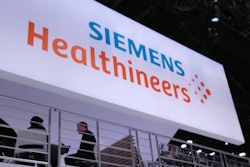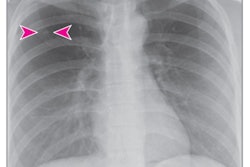
A new photon-counting CT scanner called Naeotom Alpha is the main attraction at the RSNA 2021 booth of Siemens Healthineers this week. The company is also highlighting new product launches in MRI, conventional CT, software for women's health, and other modalities.
CT
Naeotom Alpha is the undisputed highlight in the CT section of the company's RSNA booth. The scanner was cleared by the U.S. Food and Drug Administration (FDA) in September 2021, with the agency calling the system the "first major imaging device advancement" in CT in nearly a decade.
In its RSNA booth, Siemens is educating RSNA attendees on the relatively novel nature of photon-counting CT, which differs from traditional CT technology by using a one-step conversion process to convert x-ray photons into an electrical current that then generates the medical image, rather than the two-step process used by conventional CT. Photon-counting scanners also assess every photon separately.
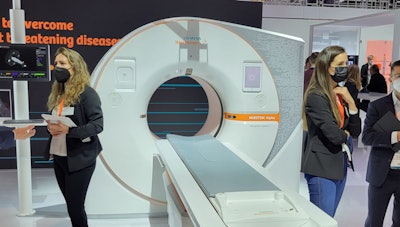 Naeotom Alpha.
Naeotom Alpha.Naeotom Alpha uses photon-counting detectors based on cadmium telluride crystals, and Siemens said it was also able to eliminate electronic noise in the detector and image chain. Early work with the system indicates that eliminating this noise enables radiation dose to be cut by as much as 50%.
Siemens believes that photon-counting CT will revolutionize the modality by offering images at higher spatial resolution with no electronic noise. Users can choose either higher-quality images, lower radiation dose, or both. The scanner also supports spectral CT.
Like other superpremium CT scanners in the Siemens product line, Naeotom Alpha is a dual-source scanner, with a 0.25-second gantry rotation time, 66-millisecond temporal resolution, and an x-ray generator with power reserve up to 1,300 mA. The system has volumetric coverage of 74 cm per second.
With FDA clearance in hand and 20 evaluation systems installed worldwide, Siemens plans to begin commercializing Naeotom Alpha, and the company is currently taking orders for the system.
But Siemens is continuing to emphasize developments in conventional CT in its RSNA booth. The company is highlighting Somatom X.ceed, the latest offering in the X family of scanners that was started with the launch of Somatom X.cite in 2019. Siemens debuted X.ceed in May 2021.
Somatom X.ceed is a more powerful version of the X.cite system, with a faster gantry rotation time of 0.25 seconds per rotation and a more powerful 120-kW Vectron x-ray tube with 1,300 mA of power reserve. Both X.ceed and X.cite sport wide 82-cm gantries. Deliveries of X.ceed are scheduled to begin this month.
On the software side, Siemens is touting myNeedle Companion, a new application for CT-guided interventional procedures. The software can be operated tableside with a tablet computer and joystick. MyNeedle Companion has received FDA clearance.
The X family scanners are also receiving a new laser guidance option called myNeedle Laser. The option comes with four lasers mounted on the scanner; as the patient is moved into the gantry, two of the lasers activate to create a crosshatch on the patient that indicates where the needle tip should be placed.
MRI
In MRI, Siemens is launching Magnetom Free.Star, a new addition to the line of high-value MRI scanners that the company started with the introduction of Magnetom Free.Max at RSNA 2020.
Like Free.Max, Free.Star is a 0.55-tesla superconducting scanner that uses the company's DryCool technology for reducing the amount of helium required to cool the magnet down to 1 liter and sealing it within the magnet: Unlike most superconducting MRI scanners, systems in the Free line don't require quench pipes. Siemens believes the design can reduce total cost of ownership by 30%.
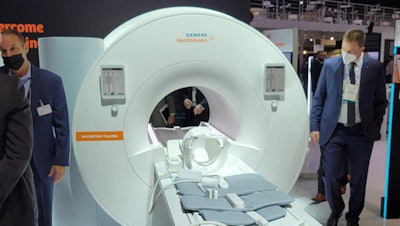 Magnetom Free.Max.
Magnetom Free.Max.Free.Star is designed for underserved geographies and areas in which MRI hasn't been used due to siting concerns or operational difficulties. Free.Star's technical specifications are similar to Free.Max, but it has a narrower 60-cm bore, compared with an 80-cm bore on Free.Max. This could limit its use with larger patients.
Siemens plans to submit a 510(k) application to the FDA for Free.Star after the RSNA meeting, and the system is being shown as a work-in-progress at the conference.
As for Free.Max, Siemens notes that it recently completed the first U.S. installation of the scanner, at the University of Michigan Health System.
Siemens is also highlighting additions to its Deep Resolve artificial intelligence (AI)-based reconstruction protocol for MR images, which was first introduced at RSNA 2020. One new protocol is called Deep Resolve Boost, which is a k-space-based reconstruction protocol that focuses on artifact reduction.
Deep Resolve Boost will enable users to acquire MRI exams with shorter time periods, such as a 15-second knee exam, with images then boosted to full image quality using the protocol. Another protocol, Deep Resolve Swift Brain, enables a brain scan to be performed in less than two minutes. The new Deep Resolve protocols will be included with the company's upcoming XA 50 software release.
Women's health
Software is taking the spotlight in the women's health area of Siemens' RSNA booth. The company received FDA clearances for two new software packages, Mammovista B.smart and teamplay Mammo Dashboard, just a week prior to the start of RSNA 2021.
Both software packages are designed to improve workflow around the analysis of breast images, according to the company. Many breast health practices have implemented powerful new technologies like digital breast tomosynthesis (DBT) but are encountering challenges dealing with the volume of additional images.
Mammovista B.smart supports breast imaging interpretation across multiple different imaging modalities and reduces image loading times by 75%, according to the company. It uses AI algorithms to produce a confidence score in the probability of cancerous tissue, and also includes tools to help navigate DBT images. The application also can interface with other AI applications for breast imaging analysis, like Transpara from ScreenPoint Medical.
Meanwhile, teamplay Mammo Dashboard is an analytics package that operates on the company's teamplay Digital Health platform. It provides a snapshot of key performance indicators at an institutional, modality, and exam level, such as radiation dose, compression, and device utilization, the company said.
Both Mammovista B.smart and teamplay Mammo Dashboard are available commercially.
Radiography
Radiography was a major focus of Siemens' booth at RSNA 2020, and this year the company is exhibiting many x-ray systems that have received FDA clearance since they were launched last year.
Two of those systems are Multix Impact, a floor-mounted digital radiography (DR) system, and Multix Impact C, a ceiling-suspended system. The systems include myExam Companion, software from Siemens that guides radiologic technologists and radiographers through exam setup and image acquisition.
Newly integrated into the systems is a 2D camera that enables technologists to view patients at all times. Siemens has incorporated functionality into the camera that allows technologists to perform functions like adjusting collimation using a touchscreen; the company believes this can help cut 20% from exam setup time.
For the Multitom Rax system, Siemens is highlighting True2scale Body Scan, a full-body slot-scanning protocol that produces two panoramic images in one run. Patients can be standing, seated, or supine, giving users additional positioning flexibility, and the system also supports 3D weight-bearing studies. Siemens is highlighting the technique's slot-scanning design, which reduces radiation dose. FDA clearance is pending for the technology.
Other x-ray highlights include a 3D camera now available on Ysio Max, the company's premium radiography system. The camera enables users to examine the shape of a patient and perform automated collimation.
Luminos Lotus Max is the company's newest remote fluoroscopy system, with the first U.S. system installed in October 2021. The company is highlighting new features designed to help with workflow, such as a wireless footswitch that enables users to initiate functions such as "last image hold" and "store fluoro video."
Siemens has also added a mood lighting option to Luminos Lotus Max. The company acknowledges that fluoroscopy procedures can be intimidating for some patients; especially children. The option enables technologists to choose color options designed to put patients at ease during their procedures.
Finally, Siemens is highlighting new software features that include proactive fluoro loop, digital zoom, histogram dose regulation, and a snapshot mode that produces static images from fluoro loops automatically. The features are being offered as options and customers can choose the ones they want.
Molecular imaging
Biograph Vision Quadra is the flagship PET/CT scanner from Siemens that is occupying pride of place in the company's booth after receiving FDA clearance earlier this year. A major differentiating feature of the system is its wide 106-cm axial field of view.
Vision Quadra's large field of view enables it to perform simultaneous whole-body imaging from the top of the head to the thigh, and its field of view is four times larger than the company's Biograph Vision 600 system.
Siemens is highlighting the Vision Quadra's 3.2-mm detector elements based on silicon photomultiplier (SiPM) detector technology, as well as time-of-flight (ToF) performance. This combination enables more anatomical coverage of a patient in one bed position than a standard PET/CT scanner as well as higher image quality.
Important capabilities of the system include multiorgan tracer kinetics, rapid whole-body dynamic and parametric imaging, PET angiography, fast scanning protocols for pediatric patients, breath-hold PET/CT, and the ability to image challenging radioisotopes like zirconium-89.
Meanwhile, the recent bounce back in the market for office-based nuclear cardiac imaging has prompted Siemens to relaunch c.cam, a dedicated cardiac gamma camera, in September 2020. Major features of the system include a reclining chair and cardiac imaging software applications from the University of Michigan and Cedars-Sinai Medical Center.
Digital health
In digital health, Siemens is focusing on streamlining management of radiology operations and diagnostic decision making. The company's teamplay digital health platform was launched in March 2020 as a technology to help radiology departments get better insights on their operations.
The technology is being marketed as an edge-based computing platform, a paradigm that has elements of cloud computing but enables users to keep data storage closer to their institution. Siemens has found that giving customers an edge computing option helps them benefit from some aspects of cloud computing like access to upgrades, while keeping data locally as a sort of hybrid configuration.
Another new addition to the teamplay family, teamplay Performance Assistant, guides users to address the most critical areas of need in their departments and see where there are operational shortcomings, such as how to best utilize scanners in their facility.
In the company's Medicalis family of software, Siemens is demonstrating the ability for patients to do their own self-scheduling, such as for follow-up appointments. The application can be integrated with a hospital's own electronic health record and scheduling system.
Siemens is also highlighting recent new modules in its AI-Rad Companion line of applications for assisting radiologists with image interpretation. New enhancements for chest CT include a time-point comparison tool for lung nodules that enables radiologists to compare the current measurement of a lesion with a previous study of the same nodule. This application is pending 510(k) clearance.
Also new is a brain MRI module designed to improve analysis of white-matter hyperintensities, which can be a sign of early development of multiple sclerosis. This model is also pending 510(k) clearance.
Finally, Siemens is demonstrating AI-Pathway Companion to guide therapeutic decisions that might be needed after a diagnosis. The company is also planning to launch AI analysis for digital pathology.
In its syngo family of enterprise image management software, Siemens is focusing on helping institutions bring together and integrate data from disparate sources and then apply analytics and AI to improve decision-making. Syngo Carbon is the company's flagship offering here, and it was launched at RSNA 2020.
Syngo Carbon gives users a single interface for not only viewing images across different -ologies but also using advanced visualization tools, as well as AI and computer-aided detection applications. It supports both DICOM and non-DICOM data. The data management element of Syngo Carbon is shipping, while the front-end elements are pending 510(k) clearance.
Interventional radiology
Cios Flow is a new mobile C-arm that Siemens is highlighting in the advanced therapy and angiography section of the company's booth. The C-arm received FDA clearance in January 2021.
Cios Flow is designed to be a department's workhorse mobile C-arm, and it is suitable for guiding procedures across multiple clinical areas, according to the company. The company is touting the device's low weight, maneuverability, and touchscreen, as well as its ease of use.
Features on the system include SpotAdapt, which automatically optimizes imaging parameters based on the anatomy being targeted. Users can collimate, rotate, and flip images with a single finger, according to Siemens.
Siemens is also pointing out Cios Flow's Retina imaging chain with a flat-panel digital detector based on complementary metal-oxide semiconductor (CMOS) material, system weight of 606 lb (275 kg), and 2.3-kW generator. The C-arm is available in configurations with 12-inch and 8-inch detectors.
Ultrasound
New software releases for the Acuson Sequoia and Acuson Redwood scanners are the highlights in the ultrasound section of the Siemens booth.
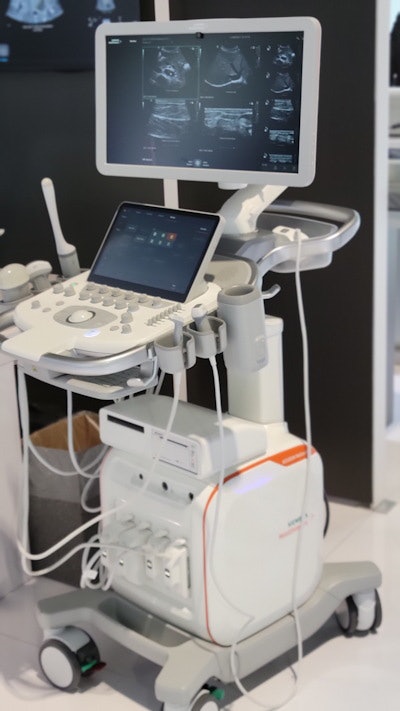 Acuson Redwood.
Acuson Redwood.The flagship Sequoia scanner is receiving updates that include an advanced liver analysis package that addresses challenges in managing liver disease. It includes better workflow for liver elastography applications using the company's ultrasonically derived fat fraction (UDFF) application, which classifies hepatic steatosis as intrahepatic fat that is greater than 5% of total liver weight. The tool performs in a similar way as MRI-based proton density fat fraction (PDFF).
Another new tool is autopoint shear-wave elastography, which acquires up to 15 shear-wave measurements at a time. Combining this technique with UDFF can reduce the exam time of liver elastography studies.
A third highlight for Sequoia is a virtual workstation that allows users to access and interface with PACS and HIS/RIS networks from the ultrasound scanner. The feature is designed to take advantage of the increasing number of exams being performed at patient bedside, according to the company.
For the Acuson Redwood shared-services scanner, Siemens is launching a 2.0 version of the scanner's operating software. This includes new feature sets and transducers, as well as new applications for endovaginal and advanced abdominal studies, as well as a new hockey-stick transducer for musculoskeletal use, and image enhancement to enable the system to scan as deep as 40 cm.
Siemens has 510(k) clearance on all the new technologies for Sequoia and Redwood.





